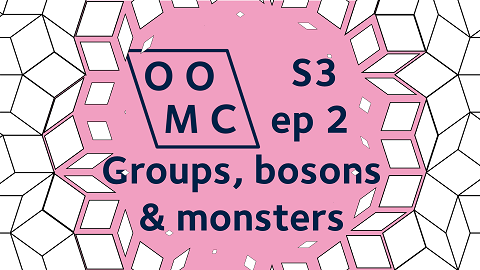Season 3 Episode 2

In this episode, Jonah introduces group theory with symmetries of a square, and talks about the Higg's Boson and the Monster Group.
Further Reading
Symmetries of a Square
Jonah talked about square and triangle. What about other regular polygons? How many symmetries does a regular pentagon have? What about a hexagon? (And so on???)
Once you’ve found all the symmetries of a square, you know that performing one of these operations then another must be equivalent to one single operation. For example, "rotate by 90 degrees" then "reflect in the vertical line of symmetry" has the same result as "reflect in a diagonal line of symmetry". It’s possible to make a sort of multiplication table to show the effects of all these combinations of operations (there would be eight rows for the eight possible “first operations” and eight columns for the eight possible “second operations”, 64 combinations to try out). If you make a multiplication table like this, we’d love to see it! With permission from a parent or guardian, you could send us a scan or photo of your work to the OOMC email address below.
Number of Symmetries
The number of symmetries of a square turned out to be 8. That’s not the same as the number of permutations of ABCD (there are 24 of those), so the group of symmetries of a square is not isomorphic to the group of symmetries of ABCD. Only a subset of the permutations ABCD correspond to symmetries of a square. When we’ve got one group that’s a subset of another group like this, we say that the smaller one is a “subgroup”. Here the subgroup has 8 elements and the group of all permutations has 24 elements. Note that 8 is a factor of 24... this is not a coincidence - it's an example of something called Lagrange's Theorem (that link goes to Wikipedia, so there are two or three helpful sentences at the top, then it quickly gets too technical for us right now!).
Group Theory
This seems like a good place to state the definition of a group.
A group is a set of elements with a binary operation. “Binary” here means that it takes two elements; it’s unrelated to the binary way to represent numbers that you might have seen. The operation might be written like this $a*b$ (to make it look a bit like addition or multiplication), and the group must satisfy the following properties;
- Identity: there is an element of the group (usually called $e$) such that $a*e=a$ and $e*a=a$ for all elements $e$.
- Closure: if $a$ and $b$ are in the group, then $a*b$ is in the group.
- Inverses: for each element $a$, there is an element $b$ such that $a*b=e$ and $b*a=e$. The inverse is usually written $a^{-1}$.
- Associativity: if $a$ and $b$ and $c$ are in the group then $a*(b*c)=(a*b)*c$.
Definitions like this play a special role in mathematics; if something obeys the rules above, then it's a group, and if it doesn't obey those rules then it's not. If I want to prove something about groups, then I have to use the rules above, or things that have been deduced from those rules.
Some groups also have the property that $a*b=b*a$ for all elements a and b. Those groups are called “commutative groups” or “Abelian groups” after the mathematician Niels Abel.
There are some exercises to try, using those definitions above, on NRICH.
If you made a multiplication table above, check whether the group of symmetries of a square is Abelian. If you assumed that $a*b=b*a$ while you were making your multiplication table, check that assumption!
To see some more examples of small groups, see this NRICH article.
Group theory used to be an A-level Further Mathematics option on some exam boards (I’m not sure if it still is). If you’d like a sense of what that was like, here’s a revision video made by the FMSP. I’ve linked to it because the start of the video includes a very fast summary of what used to be taught, which might give you ideas for more things to look up or to try. Since that video was made, the FMSP has changed name to AMSP but they’re still making content to help people studying Maths and Further Maths in schools in England (your teachers may be able to get access to free helpful resources via the AMSP).
If you want to get in touch with us about any of the mathematics in the video or the further reading, feel free to email us on oomc [at] maths.ox.ac.uk.

